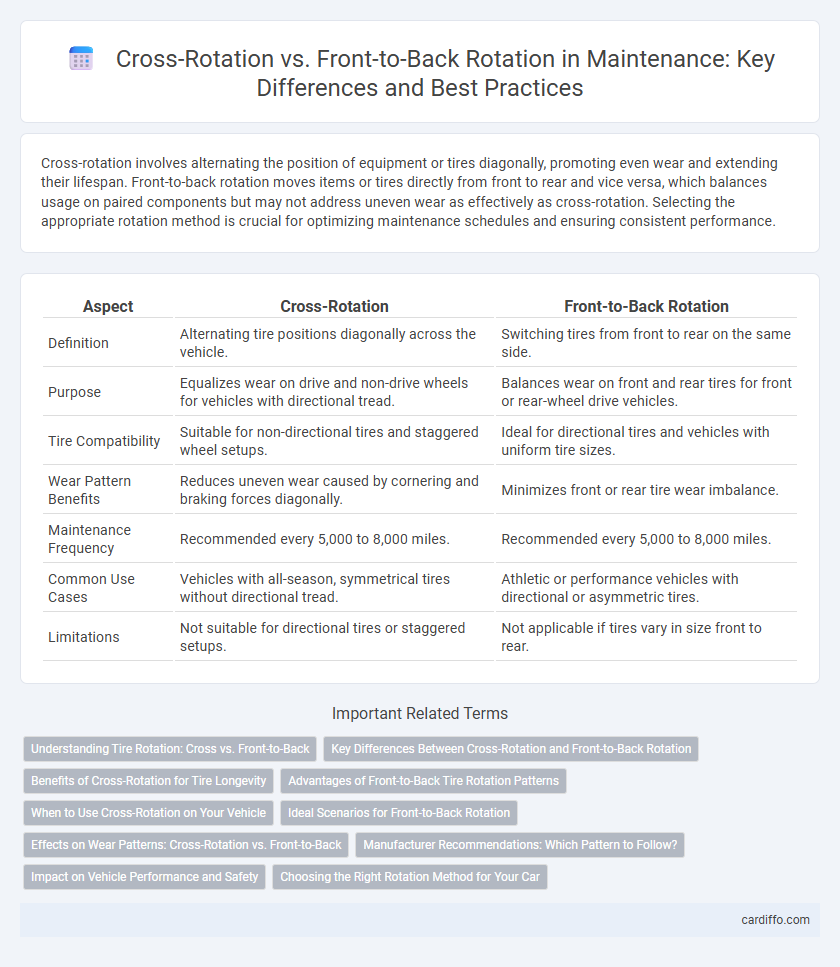Cross-rotation involves alternating the position of equipment or tires diagonally, promoting even wear and extending their lifespan. Front-to-back rotation moves items or tires directly from front to rear and vice versa, which balances usage on paired components but may not address uneven wear as effectively as cross-rotation. Selecting the appropriate rotation method is crucial for optimizing maintenance schedules and ensuring consistent performance.
Table of Comparison
| Aspect | Cross-Rotation | Front-to-Back Rotation |
|---|---|---|
| Definition | Alternating tire positions diagonally across the vehicle. | Switching tires from front to rear on the same side. |
| Purpose | Equalizes wear on drive and non-drive wheels for vehicles with directional tread. | Balances wear on front and rear tires for front or rear-wheel drive vehicles. |
| Tire Compatibility | Suitable for non-directional tires and staggered wheel setups. | Ideal for directional tires and vehicles with uniform tire sizes. |
| Wear Pattern Benefits | Reduces uneven wear caused by cornering and braking forces diagonally. | Minimizes front or rear tire wear imbalance. |
| Maintenance Frequency | Recommended every 5,000 to 8,000 miles. | Recommended every 5,000 to 8,000 miles. |
| Common Use Cases | Vehicles with all-season, symmetrical tires without directional tread. | Athletic or performance vehicles with directional or asymmetric tires. |
| Limitations | Not suitable for directional tires or staggered setups. | Not applicable if tires vary in size front to rear. |
Understanding Tire Rotation: Cross vs. Front-to-Back
Cross-rotation involves rotating tires diagonally, moving front left to rear right and front right to rear left, which helps even out tire wear on vehicles with non-directional tires. Front-to-back rotation transfers tires straight from the front axle to the rear axle on the same side, suitable for directional tires to maintain tread pattern orientation. Proper understanding of cross and front-to-back tire rotation patterns ensures extended tire life and consistent vehicle handling.
Key Differences Between Cross-Rotation and Front-to-Back Rotation
Cross-rotation involves rotating aircraft tires diagonally to equalize wear between opposite corners, enhancing tread life and maintaining balanced handling. Front-to-back rotation swaps tires between the front and rear axles on the same side, optimizing tire wear patterns for vehicles with uniform tire sizes and consistent load distribution. Understanding these key differences helps in selecting the appropriate rotation method to maximize tire performance and safety based on vehicle type and driving conditions.
Benefits of Cross-Rotation for Tire Longevity
Cross-rotation extends tire longevity by promoting even tread wear across all tires, reducing the risk of uneven degradation common in front-to-back rotation patterns. This method balances the load and grip variations experienced by front and rear tires, enhancing overall traction and tire life. Regular cross-rotation maintenance can lead to improved fuel efficiency and safer handling by maintaining consistent tread depth throughout the tire set.
Advantages of Front-to-Back Tire Rotation Patterns
Front-to-back tire rotation patterns promote even tread wear by maintaining tires on the same side of the vehicle, which is crucial for vehicles with directional tread designs. This method enhances traction and handling consistency, leading to improved vehicle stability and safety during operation. Regular front-to-back rotations extend tire lifespan and optimize performance by preventing uneven wear commonly caused by different load distributions between the front and rear axles.
When to Use Cross-Rotation on Your Vehicle
Cross-rotation is ideal for vehicles with different tire sizes or staggered wheels, ensuring even wear by rotating tires diagonally between opposite corners. Use cross-rotation when your vehicle's owner manual specifically recommends it, particularly on front-wheel-drive vehicles to balance tread life and improve handling. Avoid cross-rotation if your tires are directional or have asymmetric tread patterns, as improper rotation can decrease tire performance and safety.
Ideal Scenarios for Front-to-Back Rotation
Front-to-back rotation is ideal for maintenance tasks that require consistent airflow through equipment or duct systems, ensuring even wear on components exposed to directional forces. This rotation method suits HVAC systems or industrial fans where contaminants and particulates predominantly enter from one side, allowing filters and blades to undergo balanced usage. Implementing front-to-back rotation extends equipment lifespan by preventing uneven degradation caused by unidirectional stress.
Effects on Wear Patterns: Cross-Rotation vs. Front-to-Back
Cross-rotation evenly distributes tire wear by alternating tires diagonally, minimizing uneven tread degradation and extending tire lifespan. Front-to-back rotation maintains consistent wear patterns by swapping tires between the front and rear axles, which is effective for vehicles with uniform tire specifications. Understanding these wear effects helps optimize maintenance schedules and improve vehicle safety performance.
Manufacturer Recommendations: Which Pattern to Follow?
Manufacturer recommendations for tire maintenance emphasize following the vehicle-specific rotation pattern to ensure uniform tread wear and prolong tire life. Cross-rotation suits vehicles with non-directional tires and staggered wheel sizes, while front-to-back rotation is ideal for directional tires or vehicles with uniform wheel sizes. Adhering to the prescribed pattern helps maintain optimal traction, improves safety, and aligns with warranty requirements from leading tire manufacturers.
Impact on Vehicle Performance and Safety
Cross-rotation improves tire wear balance by rotating tires diagonally, enhancing vehicle stability and traction on varied road conditions. Front-to-back rotation maintains consistent front and rear tire wear patterns, preserving steering precision and braking efficiency. Proper rotation strategy directly influences tire lifespan, handling response, and overall safety during driving.
Choosing the Right Rotation Method for Your Car
Selecting the appropriate tire rotation method depends on your vehicle's drivetrain and tire type; front-to-back rotation suits non-directional tires on front-wheel or rear-wheel-drive cars, promoting even wear. Cross-rotation is ideal for vehicles with non-directional tires and all-wheel or four-wheel drive, balancing the wear across all tires by moving them diagonally. Understanding these rotation patterns helps extend tire life, improve handling, and maintain optimal traction.
Cross-rotation vs Front-to-back rotation Infographic

 cardiffo.com
cardiffo.com